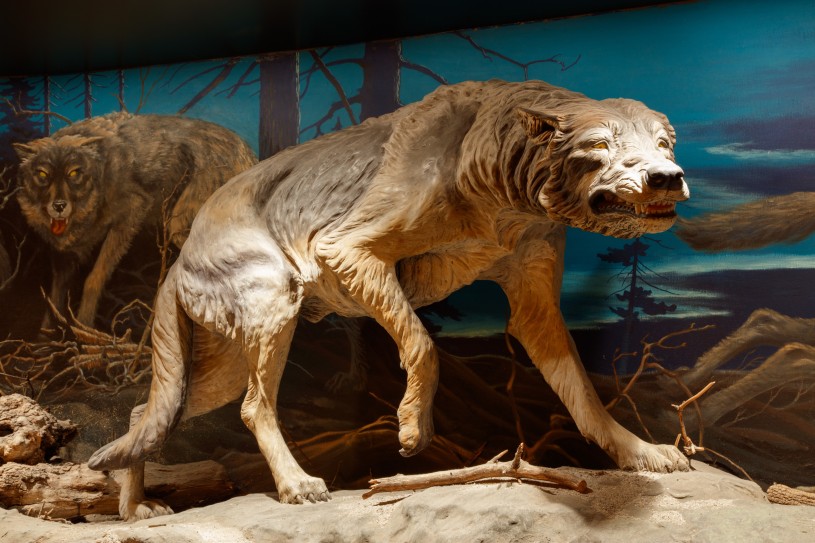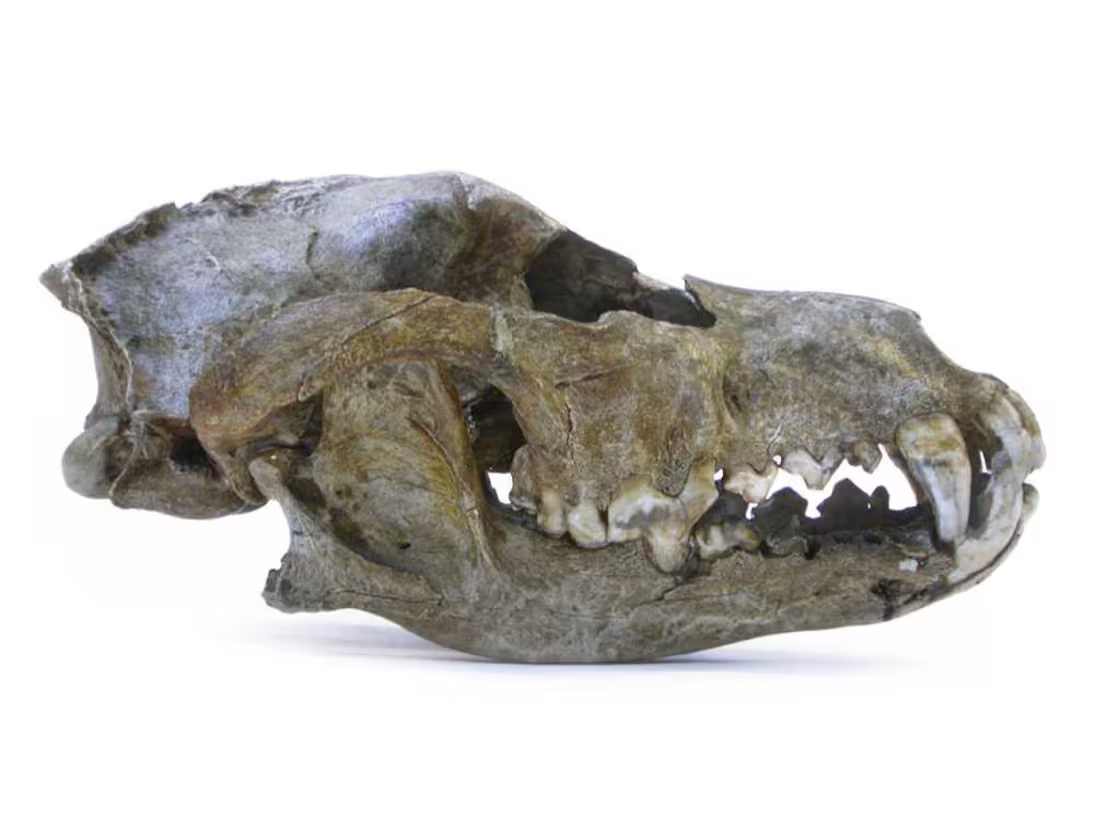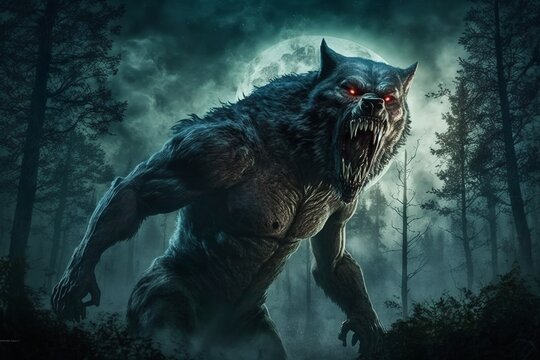 |
| Source: Adobe Stock |
How scared would a modern inhabitant of planet Earth be if someone met one of these ancient relatives of the dog Amphitheatre on a dark night, also known as the bear dog? These creatures possessed frightening dimensions, with a length of 2.5 m that's almost 8 1⁄2 feet long and a weight of 500 kg, that's a gargantuan 1,100 pounds, or roughly 1⁄2 a tonne.
This beast was really creepy and scary. Imagine that this monster is something like what you would get if you put a bear's head on the body of a giant dog with jaws. They could easily chomp right through the bones of large animals. This is exactly how the bear dog looked, perhaps fortunately for us but definitely sad for them.
 |
| When combined with coffee, will increase your speed and efficiency of metabolism READ MORE |
Bear dog: An ancestor of killing machine
The bear dog disappeared from the face of the earth 9 million years ago, long before the appearance of Homo sapiens. Perhaps if our ancestors had had the opportunity to encounter such a creature, they would have been much less likely to have had the idea to try to tame wolves into dogs.
I must mention that despite the obvious similarity to a dog and the presence of a common ancestor, the bear dog is still not a mainline direct ancestor of our modern pit bulls and chihuahuas.
But then, which animal is it?
It might be that the role of the forefather of all dogs is no less impressive a beast than the dire wolf, so scientists named this largest predator of the canine family, not for the sake of wit but in all seriousness, because of its great size, about 2 m, or almost 6 1⁄2 feet, and 70 kg, or about 155 pounds, it isn't quite as fast and didn't have the dexterity of modern wolves?
 |
| Dire Wolf | Source: La Brea Tar Pits |
However, its massive muscles and huge, deadly, sharp canines turned this dire wolf into a ruthless killing machine, able to easily take down a mastodon or even a giant sloth😮. This monster only died out about 10,000 years ago, so interaction with Homo sapiens was inescapable, but this did not end in interspecies friendship.
How and when these beasts became our friends?
Later, the traditional grey wolf appeared on the scene, which man eventually managed to tame, gradually turning this heretofore wild animal into what we now know.
Authorities on this matter explain this sequence of events; thusly, ancient peoples picked up some wolf puppies somewhere and raised them for their own needs. As a result, this spirited predator became an affectionate and obedient animal, but a group of American geneticists now has a different opinion.
Authorities on this matter explain this sequence of events; thusly, ancient peoples picked up some wolf puppies somewhere and raised them for their own needs. As a result, this spirited predator became an affectionate and obedient animal, but a group of American geneticists now has a different opinion.
 |
| When combined with coffee, will increase your speed and efficiency of metabolism READ MORE |
These scientists analyzed the genomes of more than 1 1⁄2 thousand dogs, belonging to 161 different breeds. As it turns out, despite the external differences, the dogs studied were all basically the same genetically; however, surprisingly, no close genetic link was found with wolves. Such a turn of events led researchers to the idea that these animals, at some point, developed separately from each other naturally and can be referred to as distant cousins descended from some common progenitor of the predatory mammals.
In short, these scientists suggest that man has never tamed the wolf but immediately took up the domestication of the dog, and the misconceptions regarding the heretofore proposed ultimate genetic paternity provided by wolves are explained by the fact that even those separate species of these animals sometimes make it confusing to geneticists all over the world.
When the scientists found oldest dog remains
The oldest dog known to science, whose remains were found in present-day Belgium, lived some 31,700 years ago. In appearance, it somewhat resembles a Siberian husky, only with a size somewhat closer to that of a large shepherd and slightly enlarged teeth, with which it nods on the carcasses of musk oxen, horses, and deer.
 |
| Source: NBC |
Whether it had a master who walked their anti blue V and petted out the front door of their cave every morning is still unknown, as is the timing of exactly when domestication occurred. Scientists simply cannot agree, referring to a range of different time intervals from 10,000 to 40,000 years ago, but the most interesting thing is how this friendship between man and dog began. Indeed, many scholars believe that people didn't simply tame our four-fingered friends; they were domesticated.
Some of these puppies learned that they didn't have to compete with Homo sapiens for prey. A young pup perhaps quickly learned that it was much easier—just wag its tail, drop its ears, and show its human carer that it was ready to carry out commands. Its master would then give their newfound canine Chum everything it wanted.
Some of these puppies learned that they didn't have to compete with Homo sapiens for prey. A young pup perhaps quickly learned that it was much easier—just wag its tail, drop its ears, and show its human carer that it was ready to carry out commands. Its master would then give their newfound canine Chum everything it wanted.
 |
| When combined with coffee, will increase your speed and efficiency of metabolism READ MORE |
Humans and dogs: Traces of friendship from our history
Thus, 1000s of years ago, dogs began to help people hunt game and graze cattle, protecting the ladder from other predators. Over time, our ancestors, when breeding dogs, learned how to select for the more desirable or useful qualities of such animals.
Thanks to this, for example, in ancient Egypt, some early hunting dogs were bred to have vastly superior speed, allowing them to catch the fast and elusive gazelle. In another ancient state, Rome, people decided to extend the functionality of the dog, turning these pets from hunters, shepherds, and watchmen into real fighters.
| Source: Quora |
These military dogs were hit by a variety of wild animals, often turning the entire affair into a royal bloody mess. However, with the fall of the Roman Empire, the animals became wild, terrifying local people's, and gave rise to many myths and legends regarding the so called werewolves👇.
 |
| Source: Adobe Stock |
It wouldn't be surprising if the doggy heroes of this ancient lore might be representatives of the giant Tibetan Mastiff breed. The first recorded references date back to 1120 B.C. Once the dog finally found its way to the British Isles, this Tibetan giant eventually dropped its thick coat of fur and turned into the more well-known English mastiff.
Modern era's giant dogs
It is the largest breed of dog in the world today. The height of this champ at the withers, that is, from the pause to the highest point on its spine, often reaches 90 cm or about 35 inches; that's almost a yard, and the mass of this gargantuan feast regularly reaches over 100 kg or 220 pounds, but a famous English Mastiff named Zorba really outdid himself, triumphing with 2.5 m or 8.2 feet in length and 94 cm or 37 inches at the withers, with this amazing canine weighing in at the time of the record a little more than 155 kg or 343 pounds. His record remains unbeaten to this day. But unfortunately such type of dogs die early than other normal dogs.
 |
| Zorba | Source: k9rl |
According to one doctor, Cornelia Kraus from the University of Göttingen. After analysing information on dogs from 74 different breeds, Dr. Kraus came to the conclusion that the reasons for this early death is just the same for all of our four footed friends.
According to the assumptions of the researcher, life expectancy can even be calculated for every two kg of animal mass—one month from their potential lifespan. According to Dr. Kraus, another enemy of these giant breeds is cancer, whose higher occurrence is explained by the accelerated growth of these dogs and, accordingly, their early ageing, which leads to the development of abnormal ells.
 |
| When combined with coffee, will increase your speed and efficiency of metabolism READ MORE |
The mystery behind this long lived mutual affection
Thousands of years of living side by side with people have led not only to external changes for our furry canine pals, but these lovely and fascinating creatures have also undergone some changes to their intellectual abilities. Surely many of us would love to hear about the special mental capabilities of our dogs, but they are not really quite as smart as we had previously assumed.
Scientists also has done a meta-analysis evaluating 300 studies regarding the intelligence of animals. They found that hyenas, raccoons, and dolphins perform many tasks much better than domestic dogs, due to our great love for these faithful creatures. Even scientists tend to put more emphasis on dog research, exaggerating its merits while often underestimating the rest of the animal world.
 |
| When combined with coffee, will increase your speed and efficiency of metabolism READ MORE |
In fact, a dog doesn't really need to undertake such strenuous mental efforts, as it's often enough for it to simply gaze with canine compassion into the eyes of its master.
Who has no choice but to immediately fulfil their devious pet's desire?
However, we must not allow such arguments to make us less loved by our funny, furry friends. After all, this love is mutual. In fact, these feelings take place at a hormonal level. When a master Homo sapiens and a dutiful canine familiaris look at each other, a small release of oxytocin occurs.
This is the hormone responsible for trust and affection. The whole mystery of this amazing friendship between man and dog has still not been solved, as in the natural world this connection no longer exists. However, the very existence of a creature that can love us human beings more than they love themselves is really worth appreciating, and we cannot forget that this most devoted companion has been wagging his tail in friendship with us for more than 10,000 years.
However, we must not allow such arguments to make us less loved by our funny, furry friends. After all, this love is mutual. In fact, these feelings take place at a hormonal level. When a master Homo sapiens and a dutiful canine familiaris look at each other, a small release of oxytocin occurs.
This is the hormone responsible for trust and affection. The whole mystery of this amazing friendship between man and dog has still not been solved, as in the natural world this connection no longer exists. However, the very existence of a creature that can love us human beings more than they love themselves is really worth appreciating, and we cannot forget that this most devoted companion has been wagging his tail in friendship with us for more than 10,000 years.
 |
| When combined with coffee, will increase your speed and efficiency of metabolism READ MORE |

